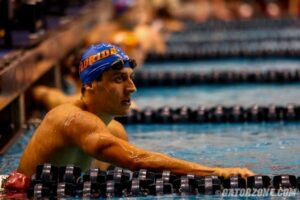Courtesy: Carlos Omana
Shoulder pain is something I think most, if not all, swimmers deal with at some point in their careers. More often than not, shoulder discomfort is a byproduct of overuse and dysfunction at the shoulder girdle. Let’s first take a look at what may be causing discomfort and dysfunction.
Muscles of the upper body that produce a lot of force and are excellent at propelling the body forward in the pool include the pectorals, latissimus dorsi, and upper traps. We’ll call these our force output muscles. Even though we want these muscles to be very strong and useful, we also need to mitigate the effects they have on the position of the body. Both the pectorals and latissimus dorsi internally rotate the shoulder. The upper traps retract the shoulder blades, but can also elevate them. Without mitigation, the upper body can end up in a poor posture position called upper cross syndrome. Common symptoms of upper cross syndrome are rounded upper back, forward head position, shoulders and hands turned in towards the mid-line of the body, and discomfort in the shoulder girdle.
In order to keep our force output muscles in check, we need our force management muscles. These would include our mid and lower trap fibers, rhomboids, serratus anterior, and muscles of the rotator cuff (specifically the infraspinatus and teres minor). These muscles, if trained consistently, can pull the upper body out of upper cross syndrome and keep the shoulder pain-free. However, in order for that to happen, the body needs to have the mobility to get into the positions where these muscles can contract appropriately and do their job.
In the context of functional mobility, the upper body works as a chain reaction from the inside out, where each part of the body structure works as a fail-safe for the previous part of the body. If a more proximal part of the body is weak or not functioning properly, then the more distal part will further assist with stabilizing the shoulder, which in some cases may cause pain or discomfort.
Shoulder Function from Proximal to Distal (closest to the body to furthest):
- Core
- Thoracic Spine/Rib Cage
- Scapula
- Humerus
The core is where a human’s center of mass usually lies. If the center of mass is stable, then movements above and below the core are in an optimal position. The core ensures proper position of the ribs and pelvis. If the ribs are in a functional position to expand and rotate, then the thoracic spine can flex, extend, and rotate appropriately.
The scapula glides along the rib cage and is dependent on the function of the thoracic spine and rib cage to move appropriately. If the thoracic spine and rib cage function appropriately, the scapula can move appropriately.
Finally, the humerus attaches to the scapula in the ball and socket joint. If the scapula can function properly, then the humerus can move and rotate functionally.
With that being said, when looking at shoulder function, if a swimmer is feeling pain in the shoulder, the site of pain may not always be the culprit. We will now work backward to find dysfunction. Oftentimes, swimmers feel pain on the side or front of the shoulder, which oftentimes is the attachment site of the rotator cuff and bicep tendon. If the rotator cuff or bicep is over-stressed and causing pain, there may be a need for more function and stability at the scapula. This means the upper back and serratus muscles need some work. If there is discomfort or pain internally, there may be a need for function and stability in the core musculature.
When addressing shoulder strength and stability, it is best to work from the inside out and start by strengthening your core, then upper back and serratus, rotator cuff external rotators, and then bicep and tricep. When addressing shoulder pain or discomfort, it is best to work from the outside in and find where dysfunction may be happening, and address it accordingly.
 ABOUT CARLOS OMANA
ABOUT CARLOS OMANA
Carlos Omana, owner of White Water Method, trained under Coach Kirk Peppas and at the University of Florida during his swimming career in addition to representing Venezuela internationally after his collegiate career. After swimming, Carlos pursued a career in strength and conditioning. He graduated with his M.S. in Human Performance and received certifications as a Certified Strength and Conditioning Specialist, USAW Level 1 Performance Coach, Performance Enhancement Specialist, and Certified Physical Preparation Specialist. In 2024, he started White Water Method which aims to help swimmers and coaches tackle physiological obstacles such as joint discomfort, technique issues, strength, power, mobility, etc. White Water Method is reinventing and improving the old school dryland training that swimmers know all too well.

